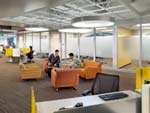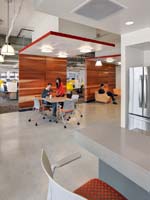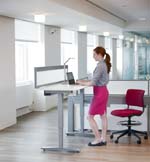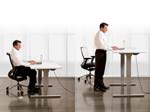
|

|
|
Home Site Search Contact Us Subscribe
|
|
A More Active Approach to Design Can Save Lives Businesses are investing billions to make their workspaces more environmentally sustainable. But they should also consider how sustainable those workspaces are for the human beings who work in them. By Jonathan Webb November 4, 2015 The average person spends more than half his day on his rear end. All that sitting is proving hazardous to his health.
According to a new study published in the Annals of Internal Medicine, sitting increases a person's risk of cardiovascular issues, cancer, and chronic disease – even if he exercises regularly and eats right. A person's chances of developing type 2 diabetes increases by 90% if she sits for eight hours a day.
The seated status quo needs to change. That change starts at work, where the average American worker logs more than nine hours a day – much of it in a chair.
Employers can lead the charge by implementing "Active Design" principles within their workspaces. This groundbreaking approach to structuring the office promotes physical activity and helps workers make healthier choices – without them even knowing it.
The obesity epidemic has been fueled by desk jobs – and it's costing companies billions. Overweight or obese workers are absent from the office a collective 1.2 million years more than their healthier coworkers. The cost of those absences? A cool $150 billion in reduced productivity.
American workers aren't just sick – they're tired, too. Artificial light tends to illuminate the office of the present. And that throws off a person's natural body clock, which regulates his or her sleep patterns. A little sunlight can do a worker good. Those who have access to natural light at the office catch an extra 46 minutes' worth of Z's each night compared to those who do not.
Active Design can address both ills. Informed by the latest health and wellness research, the approach makes the workplace, well, more active. Increasing activity levels, even unwittingly, can boost employees' health.
For example, an open-concept workspace without walls between workers compels people to walk over to meet with colleagues, rather than e-mailing or calling them. Fewer walls also mean more natural light. Real-estate firm CBRE Group has installed indirect light in its Los Angeles office, with the intent of reducing glare and employee eye strain. The workspace also automatically adjusts the level of light to conform to people's natural circadian rhythms.
Alternative workspaces, such as lounges, coffee stations, and small conference rooms, permit employees to leave their desks and work how they want, where they want.
And whether in a conventional office or an open one, a height-adjustable sit/stand desk can encourage a worker to get off his rear. This has significant benefits. Standing for two hours burns 30% more calories than sitting. Standing three hours every day for a year equates to running 10 marathons.
All that standing won't do much good, though, if workers continue to wolf down burgers and fries. That's why Active Design also emphasizes healthy eating at work. Companies can play along by making the healthy choice the default option.
Google has done so by creating a color-coded system to differentiate between healthy and non-healthy options. The company also serves food on smaller plates and makes junk food harder to reach. SAS, a Cary, North Carolina, business intelligence and software firm, subsidizes cafeteria food for employees, and provides at least one heart-healthy and one vegetarian option each day.
American businesses are investing billions to make their workspaces more environmentally sustainable. But as they build or renovate their offices, they must also consider how sustainable those workspaces are for the human beings who work in them.
Americans spend upwards of one-third of their lives at work. Their employers must ensure that those long hours at the office aren't unduly harmful to workers' health. Active Design can help them do so – to their benefit and that of their employees.
Jonathan Webb is the vice president of business markets at KI Furniture.
|
(click on pictures to enlarge)  KI An online retailer located in Washington specified a mix of open plan workstations, lounge areas, and conference spaces to promote a higher level of engagement and movement.  KI Incorporate a variety of workplace settings, such as café spaces or lounges, to encourage employees to “get up and go.”  KI A height-adjustable sit/stand desk can encourage staffers to get off their rears. Standing three hours every day for a year equates to running 10 marathons. Pictured: WorkUp® adjustable table from KI.  KI To combat issues related to prolonged sitting, outfit the workplace with a height-adjustable sit/stand desk. Pictured: Toggle® height-adjustable tables from KI. |
© 2015 ArchNewsNow.com